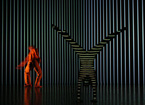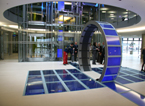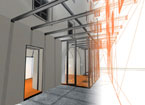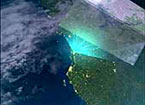| |
|
|
|
|
||
|
||||||||||||||||||||
|
|

S ince its very inception, Ars Electronica's focus has
been on the tension and interplay at the nexus of art, technology and society.
Formulating and implementing the future manifestations of this interaction is
the chosen mission of the Ars Electronica Futurelab.Artists work in ateliers and researchers in laboratories, don’t they? The approach to content and to doing a job that has been developed by the Futurelab, Ars Electronica’s media art R&D lab, brings together these two concepts in a single workplace that combines the analytical and experimental aspects of a laboratory with the artistry and creativity of an atelier. The result is a space in which the tone is set by activities of transdisciplinary teams and which, depending on the demands of a particular assignment, is continually being reconfigured as a lab-atelier or atelier-lab. Here, these two opposites blend into a way of approaching projects that is most decidedly different from classical working models. The conceptual core can be found in an artistic-creative way of dealing with substantial possibilities of interlinking technologies and content. This is the result of the diversity of the team members involved in and contributing knowhow to the particular project, and this diversity, in turn, brings forth, above all, synergies issuing from highly specialized hybrid disciplines including those leading-edge fields that have not yet gotten established in academia. The staff of this 750-m2 atelier, lab and workshop currently includes about 50 artists and researchers working on the conception, planning and realization of joint projects and commissioned assignments involving clients and associates worldwide; these men and women are computer artists, computer scientists, physicists, media and product designers, architects, game developers, telematics engineers, sociologists, art historians and scholars in the fields of cultural studies and communications. T he methodology of Shared Creativity that characterizes
the entire working process gives rise to the emergence that is typical of the
atelier-lab's creations. In phases of intensive, multidirectional processes
of exchange, various inspirations, perspectives and approaches crystallize into
a concept for the project's content and design. The idea that emerges from the
atelier becomes a prototype in the lab; in the lab, the prototype becomes the idea.
The results are approaches to solutions, that are, in accordance with the definition
of emergence effects, irreducible to the initial configuration of elements and
thus more than the sum of the inputs that were added. Another characteristic is the unpredictability that, in this context, describes the originality of the approaches to solutions, since such concepts, with respect to both content and design, are derived from what are often only vaguely formulated demands and wishes of the commissioning client and the individual framework conditions for the specification of the project results. In going about this, Ars Electronica Futurelab staffers work out their project typologies that, as an outgrowth of this approach focused on the process of mediating human-machine interaction in the real world, in screen-based media, and in 3D spaces, do not take the contact nexus as their point of departure in conceptualizing human-computer interfaces, but rather the aesthetic, content-based and functional dramaturgies that develop in the interaction. The shift in emphasis from the creation of interactive installations for the Ars Electronica Center to carrying out projects for and in collaboration with commissioning clients clearly attests to an opening of the market for this kind of know-how. The areas of application range from culture and education to industry and commerce. On one hand are the artistic productions staged in concert halls worldwide; on the other hand, there are the architectural designs of the interiors and exteriors of buildings. Both are expressions of the changed social perception of the use of media technologies, of the modes of mediating the public's encounter with content that such use makes possible, as well as of the content itself.  I
n the scope of a series of projects, the Ars Electronica Futurelab works out
approaches in the field of Media Performances
by means of which the musical works are linked up to computer-supported means
of artistic expression to engender new performance practices for stage productions.
Working out visual modes of interpretation for music, song and dance leads
to an expansion of the classical concept of artistic genres and, in turn,
to the formulation of innovative artforms whose specific characteristics manifest
themselves in how the work is produced and performed and how the audience
partakes of it. A
series of projects in the working area in Media Art and Architecture
- one with its own specific concept and design - displays emergence effects
in the way the individual demands of the structure are combined with the
media art approach of the atelier-lab into prototypes of context-sensitive
architecture, and these can be used as a visual expression of a company's
corporate culture while fulfilling certain functional tasks. T he
Ars Electronica Futurelab defines Information Design as the art and science of using the techniques
and tactics of content configuration & display to make the complex accessible, the hidden perceptible
and the undepictable visually eloquent. With regards to the functional, aesthetic and content-driven
demands of every project's context, synergies among contents and new approaches to them are worked out.
The upshot: perspectives and realities become variable and comparable; bringing forth otherwise unthinkable
processes of exchange and ways of looking at interrelationships.  I
n the working area Exhibits, the Atelier-Lab
focuses on conception, planning and execution of dramaturgical and design
approaches to mediating the public's encounter with content or to supporting
mediation processes through the use of media art. The designs of corresponding
scenarios are derived from the content supplied by the commissioning client
and the resulting demands that the content places on the mediation process.
The design is then implemented in the form of interactive exhibition and
experience situations at the interface of physical and virtual realms.T he above-mentioned fields are the current specialties
that have emerged from the Ars Electronica Futurelab's core competence in the
field of Interaction Design. Interaction design as core competence manifests
itself in the lab-atelier's activities via an approach to man-machine interaction
that stays focused on the process of mediation itself-in real space, in screen-based
media and in 3D space. The idea behind a human-computer interface is not conceived
of by taking its endpoints (device–user) as the starting point, but rather on
the basis of the aesthetic, content-driven and functional dramaturgies that
develop within the interaction.Proceeding from this specific approach, the Ars Electronica Futurelab also functions as a transdisciplinary source of know-how in its R&D activities and consulting services. As a partner involved in numerous joint ventures and project networks, the lab-atelier is also a platform for regional and international exchange on a transdisciplinary level. In theory and in practice, the Futurelab designs interfaces at the nexus of applied art and business by creating and implementing a mutually understandable vocabulary and shared fields of activity. |
| © Ars Electronica Linz GmbH, info@aec.at | ||||||||||